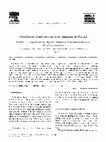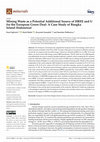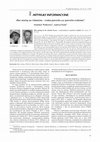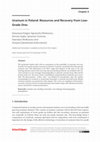Papers by Stanislaw Wolkowicz
Advanced Materials Research, 2013
The extraction of uranium from aqueous model solutions, as well as from real solutions reulting f... more The extraction of uranium from aqueous model solutions, as well as from real solutions reulting from leaching uranium ores was carried out in the system equipped with the Liqui-Cel® Extra-Flow membrane contactor with polypropylene capillary membranes. D2EHPA in toluene was used as an organic phase. Different arrangements of flow inside the membrane module were tested. The better approach appeared to be the arrangement with aqueous phase in the shell side of the contactor and organic phase inside the capillary membrane. The extraction efficiency for model solutions reached 95% and 87% for real post-leaching liquors.

Journal of Geochemical Exploration, 1997
In 1990 the Polish Geological Institute initiated geochemical mapping of the country aimed at det... more In 1990 the Polish Geological Institute initiated geochemical mapping of the country aimed at determining the actual conditions of chemistry in the Earth's surficial environments (soils. water sediments, and surficial waters as well) and hea-floor deposits in the Polish economic sector of the Baltic Sea. The geochemical mapping on different scales covered the entire area of the country and selected more important urban a pplomerations and industrial districts. Approximately 15.100 samples of soils. 16.200 samples of fresh water sediments. 13.600 samplrs of surface waters and 467 samples of marine deposits were collected and analysed. A list of geochemical atlases published by the Polish Geological Institute is presented. Investigation of the distribution of radionuclides (natural and artificial) hax been done since 1992. Concentrations of U, Th, K, post-Chernobyl Cs and y dose rate were measured. Approximately 20,000 points covering the whole country were measured. More detailed mappings were executed in the areas polluted by 0. 15 1997 Elsevier Science B.V.

Journal of Environmental Radioactivity, 2002
The aim of this work was to make a comparison of indoor radon concentrations in dwellings and in ... more The aim of this work was to make a comparison of indoor radon concentrations in dwellings and in soil air in the area of two geological formations in the Suwałki region (Poland). The mean arithmetic airborne concentration was found to be the highest (301 Bq m (-3)) in the basements of buildings in the gravel and sand areas, whereas in the boulder clay areas it reached 587 Bq m (-3). Out of 54 measurements of radon concentrations performed at the ground floor, in eight cases concentrations were found to exceed 200 Bq m (-3) - permissible radon level in new-built houses in Poland and in three cases these values were even higher than 400 Bq m (-3). The highest radon levels were noted in houses with earthen basement floors and with direct entrance from the basement to rooms or kitchens. The mean arithmetic radon concentration in the soil air in the sandy and gravel formations was 39.7 kBq m (-3) and in clay formation it was 26.5 kBq m (-3). Higher radon levels were also found in the water obtained from household wells reaching 8367 Bq m (-3) as compared with tap water (2690 Bqm (-3)). The mean indoor concentration for the whole area under study was found to be 169.4 Bq m (-3), which is higher than the mean value for Poland (49.1 Bq m (-3)) by a factor of 3.5.
Energy Sources, 2003
ABSTRACT
Chemosphere, 2004
The optimization of experimental conditions for radiolytic removal of organic pollutants from wat... more The optimization of experimental conditions for radiolytic removal of organic pollutants from water and waste with the use of ionizing radiation via controlling the concentration of target compound(s) requires also monitoring the toxicity changes during the process. Commonly used herbicides 2,4-D and dicamba were shown to increase toxicity measured with the Microtox test at low irradiation doses resulting from formation of more toxic transient products, which can be decomposed at larger doses. The changes of toxicity were examined with respect to dose magnitude and the presence of commonly occurring scavengers of radiation.

ABSTRACT Measurements of the radon concentration in indoor air were carried out in dwellings buil... more ABSTRACT Measurements of the radon concentration in indoor air were carried out in dwellings built in two lithological units i.e. sandy-gravel and clay. An integrating method of α-track detector was used. In both kinds of lithological units radon measurements in soil air were also performed. The arithmetic mean of radon concentration in air in cellars located on gravel-sandy ground was 301 Bq m -3 , and 587 Bq m -3 in clay ground. The arithmetic mean of the radon concentration in soil air in sandy-gravel area was 39.77 kBq m -3 , and in clay area -26.66 kBq m -3 . Radon concentration in the household well water in the whole examined area was higher (8367 Bq m -3) in comparison with that in the public water supply system (2690 Bq m -3). The connection between the radon concentration in soil air and the radon concentration indoors and its concentration in well water are unquestionable but the relationships between them are not simple.

Minerals, 2021
The European Commission has adopted the European Green Deal strategy, which aims to achieve clima... more The European Commission has adopted the European Green Deal strategy, which aims to achieve climate neutrality in the EU by 2050. To achieve this goal, it is necessary to shift the economy toward the use of green and renewable energy. Critical raw materials (CRMs), Li, Co, REE, Te, Sc and others, are used in renewable energy sources (RES) production. The EU lacks its own CRM deposits, and additionally, the access to already identified deposits is limited, which is making the EU countries search for alternative CRM sources. One such source of CRMs may be mining waste generated on the Indonesian island of Bangka as a result of processing cassiterite-bearing sands. Studies of the mineral composition of the waste using the XRD method reveal rich contents of xenotime (0.79–17.55 wt%), monazite (1.55–21.23 wt%), zircon (1.87–64.35 wt%) and other minerals, carriers of valuable metals, such as Sn, Ti, Nb, Ta. The point mineral chemistry analyses were performed using EPMA. Xenotime is the ma...
Biuletyn Państwowego Instytutu Geologicznego, 2016
The paper presents the development of the geological mapping of in the Sudetes and Lower Silesia,... more The paper presents the development of the geological mapping of in the Sudetes and Lower Silesia, starting from issuing in 1791 the first geological map of the Karkonosze Mountains, developed by J. Jirasek and issued in 1791, through maps of L. von Buch, C. von Raumer and A. Kaluža from the beginning of the 19th century, through and numerous editions of atlases published throughout the 19th century, ending with the detailed maps produced at the scale of 1 : 25,000 in at the beginning of the 20th century. The latter maps were the basis for the geological maps prepared after 1945.

Geological Quarterly, 2014
The his tory of mod ern geo log i cal map ping in Po land be gan with the Carta Geologica totius ... more The his tory of mod ern geo log i cal map ping in Po land be gan with the Carta Geologica totius Poloniae, Moldaviae, Transylvaniae, Hungariae et Valachiae by S. Staszic, of ten called the "fa ther of Pol ish ge ol ogy". Be fore Staszic, a gen eral map of Po land had been pub lished by J.-E. Guettard (1764a); ones of the Sudety Mts. by J. Jirasek (1791), L. von Buch (1797), and Raumer (1813); and that of the Tatra Mts. by Hacquet (1796). In times of the par ti tion of Po land (1772 to 1918), ar eas an nexed by Prus sia were cov ered by sys tem atic geo log i cal sur veys. These car to graphic pro jects re sulted in the compi la tion of two geo log i cal at lases com pris ing maps of the stan dard sheet type, in the pe riod from 1826 to 1836. These at lases were com piled by teams of out stand ing ge ol o gists, un der the lead er ship of L. von Buch and F. Hoffmann. An other out standing con tri bu tion to the ge ol ogy of Po land was made by G.G. Pusch, the au thor of the ex cel lent Geognostische Beschreibung von Polen (1833-1836), sub se quently sup ple mented by Geognostyscher At las von Polen. One of the great est achievements of L. Zejszner was the geo log i cal map of the Tatra Mts., Carte de la chaine du Tatra, pub lished anon y mously in Berlin in 1844, and a se ries of geo log i cal maps pre pared as drafts of Geognostic maps of the East ern Dis trict of the Pol ish Kingdom. Spe cial at ten tion should be also paid to two ex ten sive stud ies which cov ered ar eas of Up per and Lower Silesia. The first of these, Geognostische Karte von Oberschlesien und den Angrenzenden Gebieten, was com pleted by a team led by F. Roemer, and pub lished in 1870. The sec ond, Geologische Karte von dem Niederschlesischen Gebirge und den angrezenden gegenden, was com piled by a team led by R. von Carnall, and pub lished in the same year. Out of all the stud ies carried out by Aus trian ge ol o gists, it is nec es sary to men tion those of E. Tietze, as they pro duced ex cel lent geo log i cal maps of the Carpathians and vi cin i ties of Kraków and Lviv. It is also worth men tion ing the con tri bu tions made by the Phys io graphic Com mis sion, ac tive from 1866 un til the be gin ning of the First World War. Its mem bers de cided to pre pare the Geo log i cal Atlas of Galicia. The fi nal prod uct of works of this com mis sion was a set of 25 book lets, with over a hun dred geo log i cal maps at a scale 1:75000, is sued in the years 1885-1912. From 1881, the com mis sion was also pub lish ing its fa mous Phys io graphic Di a ries, which in clude pa pers on the ge ol ogy of ar eas an nexed by Rus sia, writ ten by fa mous Pol ish ge ol o gists such as J. Siemiradzki, A. Michalski, and E. Habdank-Dunikowski, il lus trated with rel e vant geo log i cal maps pre pared by them. Key words: old geo log i cal maps, his tory of ge ol ogy, Po land, Cen tral Eu rope.
The recovery of uranium and other valuable metals from Polish Peribaltic sandstones were examined... more The recovery of uranium and other valuable metals from Polish Peribaltic sandstones were examined. The solid–liquid extraction is the first stage of the tech-nology of uranium production and it is crucial for the next stages of processing. In the laboratory experiments ura-nium was leached with efficiencies 71–100 % by acidic lixiviants. Satisfactory results were obtained for the alka-line leaching process. Almost 100 % of uranium was lea-ched with alkaline carbonate solution. In post leaching solutions only uranium and small amounts of vanadium were present.

One hundred years of the Polish Geological Institute – an outline of the material history. A b s ... more One hundred years of the Polish Geological Institute – an outline of the material history. A b s t r a c t. Established a few months after regaining independence in 1918, the Polish Geological Institute was carrying out research aimed at ensuring the supply of necessary mineral raw resources to the domestic industry. The director of the Institute, Prof. J. Morozewicz as well as the state authorities were aware of the fact that for the proper functioning of the Institute suitable headquarter was needed. Therefore, already in the mid-1919, the appropriate area and financial resources were allocated for the construction of large buildings, the designer of which was Prof. M. Lalewicz. The laboratory pavilion was opened in 1926. The main building, which was put into use in 1936 and rebuilt after the destruction during World War II, has been the pride of the Institute until today. The extension of the state and a wide range of research issues meant that already in 1921, it was necessary t...

Mid-Atlantic Ridge area of 10 000 km, which is the initial stage of the Program of Geological Exp... more Mid-Atlantic Ridge area of 10 000 km, which is the initial stage of the Program of Geological Exploration of Oceans (PRoGeO) accepted by the Government of Poland in July 2017. On the part of decision-makers, expectations are huge in ensuring safe deliveries of a number of metals (Cu, Au, Ag, Pt, REE, Ni, Co, Zn and Mo). The authors carried out a detailed analysis of the published results of research on similar objects in the exclusive economic zones of Japan and Papua New Guinea. Comparative analysis, covering geological-economic, organizational, financial, geo-environmental aspects reveals that in the Polish zone of the MAR one can expect to find rich, but relatively small deposits of Cu, Zn, Ag, and Au, which meet the needs of a small part of domestic demand for these metals in less than 2 years. The geological and economic analysis shows that there is no risk of a collapse of the supply market for these metals. On the other hand, the risk of organizational and financial failure o...

Nukleonika, 2012
Leaching studies were performed to develop a suitable method for extraction of uranium from domes... more Leaching studies were performed to develop a suitable method for extraction of uranium from domestic uranium ores: dictyonemic shales and sandstones. The extracting procedure was composed of successive separation steps: crushing and grinding, acid or alkaline leaching, solid-liquid separation, and inductively coupled plasma mass spectrometry (ICP-MS) analyses of post-leaching solutions. The influence of such process parameters as temperature, pressure, particle size of solid material, kind of leaching solution and its concentration, on the recovery efficiency of uranium and accompanying metals were tested. The efficiency of uranium leaching with sulphuric acid solution achieved 81%. Satisfactory results were obtained for the alkaline leaching process. It was found that uranium can be selectively extracted by the alkaline leaching solution. Almost complete extraction of uranium from sandstones was achieved when a mixture of sodium carbonate and sodium hydroxide, with hydrogen peroxid...

Minerals
The growing demand for critical raw materials (rare earth elements—REE, Nb, Ta, and others) enfor... more The growing demand for critical raw materials (rare earth elements—REE, Nb, Ta, and others) enforces a need to look for their alternative sources. Distortions of the mineral supply chain caused by COVID-19 have necessitated a re-evaluation of what exists as mining waste from previous exploitation. Consequently, this study aims to provide an inventory of raw materials on the Indonesian Tin Islands (Bangka and Belitung). Geological and mineralogical examinations on Bangka have permitted an economic appraisal of tailings from the processing of cassiterite-bearing sands and confirmed the presence of REE-bearing minerals, chiefly monazite and xenotime, zircon, ilmenite, rutile, niobium-tantalum phases. In general, the mineral content of the tailings varies depending on the sampling site and the type of processing used during ore-production. ICP-MS (inductively coupled plasma–mass spectrometers) analyses revealed anomalous concentrations of LREE (light rare earth elements): La > 5%, Ce...

Uranium - Safety, Resources, Separation and Thermodynamic Calculation, May 9, 2018
The presented studies deal with an assessment of the possibility of uranium recovery from the low... more The presented studies deal with an assessment of the possibility of uranium recovery from the low-grade uranium resources in Poland. Uranium was leached from the ground uranium ores with efficiencies in 81-100% range that depend on the type of ore and leaching solution used. In the next step, the post-leaching solution was treated by the solvent extraction or ion exchange chromatography to separate uranium from other metals present in the ore. The novel routes of leaching by using membrane methods were examined. The final product, "yellow cake," was obtained in precipitation step. The studies of precipitation of uranium as ammonium diuranate or uranium peroxide from diluted uranium solutions are presented in this chapter. The work was completed with tentative economic analysis and environmental impact assessment along with radiation protection issues connected to uranium production.

Geological Quarterly, Apr 29, 2013
Krystyna WOŁKOWICZ, Stanisław WOŁKOWICZ Mineralizacja kruszcowa wschodniej strefy kontaktowej gra... more Krystyna WOŁKOWICZ, Stanisław WOŁKOWICZ Mineralizacja kruszcowa wschodniej strefy kontaktowej granitu karkonoskiego na obszarze Mniszkówa-Rędzin Omówiono grejzeny występujące we wschodniej oslonie Karkonoszy. Na podstawie przeprowadzonych badań zaliczono je do kwarcolitów. Opisano nowe wystąpienia mineralizacj i kruszcowej w Mniszkowie i Rędzinach, stw i erd zając że jest ona pochodzenia hydrotermalnego. WSTĘP Artykuł przedsta'Yia wyniki badań wykonanych w ramach prac dyplomowych w Zakładzie Geologii i Ekonomiki Złóż Wydziału Geologii UW pod kierunkiem naukowym doc. dr hab. E. Zimnoch. Prace terenowe prowadzone były w latach 1978-1980 przy wspólpracy z dr M. Lindner z Instytutu Geologicznego w Warszawie. Sporządzono mapę strefy kontaktowej granitu karkonoskiego ze skałami osłony. W badaniach posługiwano się mikroskopami optycznymi oraz mikroanalizatorem rentgenowskim typu 35-SDS, DDS, sprzężonym z mikroskopem elektronowym typu JSM-35 firmy JEOL. Autorzy serdecznie dziękują doc. dr hab. E. Zimnoch za wszechstronną pomoc w czasie prowadzenia badań , dr E. Bareji, drowi H. Sylwestrzakowi i drowi M. Podemskiemu za przejrzenie rękopisu i cenne uwagi udzielone podczas pisania niniejszego artykułu oraz doc. drowi S. Przeniosło i K. Kujawskiemu za wykonanie badań w mikroobszarze. ZARYS BUDOWY GEOLOGICZNEJ Wschodnią osłonę granitu Karkonoszy stanowi kompleks skał metamorficznych, któremu przypisuje się wiek prekambryjski i dolnopaleozoicmy. Rejon między Mniszkowem i Rędzinami zbudowany jest głównie z hornfelsów, łupków metamorficznych i amfibolitów zaliczanych przez M. Szałamachę, J. Szałamachę

First, very general geological map of Upper Silesia was elaborated by von Buch (1797/1802). On th... more First, very general geological map of Upper Silesia was elaborated by von Buch (1797/1802). On the other hand Schulze from Eisleben (1816) prepared geological cross-section from Hulczyn to Bytom, where he introduced first stratigraphic division, distinguishing among others Steinkohlengebirge. Staszic (1815) noticed on his map the presence of charbon de terre in this area. Oeynhausen map (1822) should be regarded the first modern geological map of the Upper Silesia, as containing 18 lithological-stratigraphical divisions. Further attention should be paid to maps of Pusch (1836) and Carnall (1844). The the direction of Roemer (1870) together with two-volume text, describing the geology of this area. Next important work was greatest achievement of geological cartography of the Upper Silesia in XIX century is the 12-sheet Atlas developed under the direction of Roemer (1870) together with two-volume text, describing the geology of this area. Next important work was done by Michael (1912)...

In the northern and central parts of Poland, thick layers of glacial deposits contain low uranium... more In the northern and central parts of Poland, thick layers of glacial deposits contain low uranium concentrations and low indoor radon concentrations (most < 1 pCi/l). In southern Poland, in the Sudety Mountains, crystalline rocks are known to contain enrichments of uranium. Soil developed on this terrane has relatively high soil-gas radon concentrations, and more than 50% of the indoor radon measurements exceed 4 pCi/L, the U.S. EPA recommended maximum. In the southern Poland Coal Basin, known to have radon enrichments in mines and enrichments of radium in groundwater, the soil-gas radon concentrations are low, as are the indoor radon measurements (95% < 4 pCi/L). INTRODUCTION It is generally recognized that radon potential, defined as the tendency of radon concentrations in homes to be higher than average, can be correlated to the uranium, radium and/or radon content of the soil under the home, to the permeability of the soil (more permeable soils produce higher radon homes),...

Radon and thoron and their decay products are the most important sources of radiation exposure to... more Radon and thoron and their decay products are the most important sources of radiation exposure to the general public, contributing on average about half of the total effective dose equivalent received from natural and man-made radioactivity, such situation is encountered also in Poland. The short-lived decay products of 222 Rn decay to 210 Pb with half-life of 22 years contribute to the inhaled effective dose of man. The estimation of radon risk in Poland is made on the basis of radon concentration in soil gas. The radon exhalation rate shows significant seasonal and daily fluctuations, therefore the search of measurement methods independent on these factors is still the open question. The first part of this work is devoted to measurement of 210 Pb concentration in soil and in air as the routine soil and air monitoring in Poland. The soil sampling is done in 86 places every second year. The soil samples are taken from 5-10 cm depth according to IAEA rules. The 210 Pb concentration i...






Uploads
Papers by Stanislaw Wolkowicz